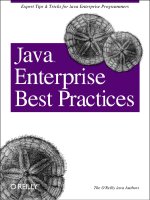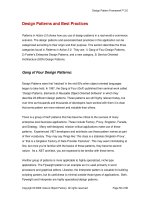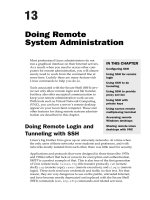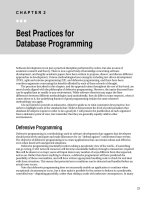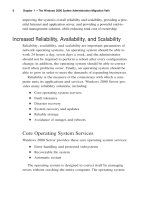debian 7 system administration best practices
Bạn đang xem bản rút gọn của tài liệu. Xem và tải ngay bản đầy đủ của tài liệu tại đây (1.71 MB, 124 trang )
www.it-ebooks.info
Debian 7: System
Administration Best Practices
Learn the best ways to install and administer a Debian
Linux distribution
Rich Pinkall Pollei
BIRMINGHAM - MUMBAI
www.it-ebooks.info
Debian 7: System Administration Best Practices
Copyright © 2013 Packt Publishing
All rights reserved. No part of this book may be reproduced, stored in a retrieval
system, or transmitted in any form or by any means, without the prior written
permission of the publisher, except in the case of brief quotations embedded in
critical articles or reviews.
Every effort has been made in the preparation of this book to ensure the accuracy
of the information presented. However, the information contained in this book is
sold without warranty, either express or implied. Neither the author, nor Packt
Publishing, and its dealers and distributors will be held liable for any damages
caused or alleged to be caused directly or indirectly by this book.
Packt Publishing has endeavored to provide trademark information about all of the
companies and products mentioned in this book by the appropriate use of capitals.
However, Packt Publishing cannot guarantee the accuracy of this information.
First published: October 2013
Production Reference: 1181013
Published by Packt Publishing Ltd.
Livery Place
35 Livery Street
Birmingham B3 2PB, UK
ISBN 978-1-78328-311-8
www.packtpub.com
Cover Image by Vivek Sinha ()
www.it-ebooks.info
Credits
Author
Rich Pinkall Pollei
Reviewers
Arturo Borrero González
Daniele Raffo
Ron Savage
Acquisition Editor
Rubal Kaur
Commissioning Editor
Govindan K
Technical Editors
Rohit Kumar Singh
Harshad Vairat
Project Coordinator
Romal Karani
Proofreader
Kevin McGowan
Indexer
Rekha Nair
Graphics
Sheetal Aute
Production Coordinator
Aditi Gajjar
Cover Work
Aditi Gajjar
www.it-ebooks.info
About the Author
Rich Pinkall Pollei's over 40 year interest in computer hardware and software
began in high school with Ohio Scientic's release of the rst kit-built computers
in the early 1970s. Later, he progressed to other systems, learning all he could of
both the underlying hardware and software architectures, eventually working as a
consulting programmer on some of the early time-sharing systems, rst at the college
he attended, and later when he worked as a Psychiatric Social Worker for the Tri-
County Human Services Center in Reedsburg, Wisconsin.
Eventually, he decided to move into Information Technology as a permanent
profession. He started as the Assistant Manager of Data Entry for Wisconsin Dairy
Herd Improvement Cooperative at a time when such departments were common.
He stayed with that company in various positions involving systems programming
and analysis, and continued to learn. He was an ofcial Beta Tester for Windows
3.0. Later, he set up the company's rst Internet e-mail system using a discarded
computer and modem, and the free version of Red Hat Linux. Total cost, not
counting the dial-up account and his time, was $0, demonstrating that: "We who
have done so much with so little for so long are now prepared to do absolutely
anything with nothing".
Eventually, Wisconsin DHIA became AgSource Cooperative Services, which
soon combined with other dairy industry-related cooperatives under a holding
cooperative known as Cooperative Resources International (CRI). Rich continued to
study and learn as computers and networking grew to greater importance in both
our personal and business lives. For a number of years, he served as an ofcial on the
Unite Conference Planning committee (Unite is an independent, Unisys User Group).
www.it-ebooks.info
Today, his ofcial position is as a Security Analyst and Systems Engineer in the
Infrastructure department of Information Technology for CRI, and he is approaching
his 35th year with the company (or its predecessors). As such, he administers a
number of Debian Linux servers, manages the ofcial Internet infrastructure (he has
one of the oldest individual handles still in use by an original registrant at ARIN),
and consults on hardware issues, software internals, networking problems, and
system and network security. He is a member of the Association for Computing
Machinery (ACM), and has contributed code to several free software projects,
including the Linux kernel, Blender, Vega Strike, and the Novell Core Protocol
Filesystem utilities for Linux.
When not playing with computers, he is a science geek, plays chess, writes and
arranges music, sings and plays saxophone and percussion in a local music group,
collects old-fashioned books and board games, and is a licensed pilot.
This book would not have been possible without the support of my
wife, Patricia, who gave up a good deal of our social time, since
my day job required me to write it outside of normal working
hours. Thanks, also, go to Sharvari Tawde of Packt Publishing, for
encouraging me to take the plunge and write my rst, full book,
and the rest of the crew at Packt Publishing for helping me through
the rough spots. I'd also like to thank my co-workers, especially
Kathleen Anderson and Jean Banker, who provided encouragement
when I was rst offered the opportunity to write this book.
Finally, to Louie and Tinkerbelle, the family cats who forced me
to take periodic breaks by jumping on the computer keyboard and
demanding attention.
www.it-ebooks.info
About the Reviewers
Arturo Borrero González has been working in the IT environment for almost 5
years now, always with Linux systems.
He is interested in networking and high availability clusters.
For the last 3 years, Arturo's job has been in Centro Informático Cientíco de
Andalucía (CICA), the regional National Research and Education Network (NREN)
of Andalusia (Spain). There, he does system administration for the Network
Information Security department.
He loves Debian and free/open-source software.
Currently he is collaborating with the Netlter project. Also, he's trying to get his
degree in IT engineering at the University of Seville.
Daniele Raffo has been a happy Linux user since the mid-1990s, and now an LPIC
certied Linux Professional. Holder of a Ph.D. in Computer Science and former
CERN civil servant, he also has experience in the elds of networking, security, and
Java programming. He is the lead author of the ofcial Handbook for Enigmail, the
OpenPGP plugin for Mozilla applications.
I would like to thank my parents and Renata for their support, and
Linus Torvalds for his extraordinary idea.
www.it-ebooks.info
Ron Savage is a semi-retired programmer who has been writing software in Perl
for a number of decades.
He has a degree in mathematics (astrophysics), but has always worked as
a programmer.
He has found that, even using Perl, he still has to write a lot of Bash, SQL, JavaScript,
HTML, and CSS to design and build databases for servers such as Postgres.
Nevertheless, while writing Perl he's had great fulllment, and endless opportunities
for expressing creativity, and has enjoyed almost every single day's work. Yes, even
the hard days.
He's always worked as a self-employed contractor, and has encountered a fascinating
range of work. Some instances are:
At BHP (an Australian mining corporation), they bought some American 'Star Wars'
technology which red radar straight down from a plane into the sea, searching
for Russian submarines. BHP adapted it to search for seams of minerals (on land),
aimed down from a wooden glider towed by a (metallic) plane, and that required
processing vast amounts of data, and new ways to visualize such data.
At Telstra (the dominant Australia-wide communications company) he wrote a lot of
code to help maintain about 15,000 network routers scattered across the country, and
which carry almost all Australian phone and Internet sessions.
Another contract was a pair of search engines written for Monash University, based
in Melbourne. One is used by staff and students, and the other is dedicated to the
telephonists. The latter uses the same database as the former, but also communicates
with a number of PABXes.
www.it-ebooks.info
Currently, he's working with Peter Stuifzand (in the Netherlands) on a short book
called The Marpa Guide. Marpa is a recent, and astonishing, generic lexer and parser
written by Jeffrey Kegler.
He also writes ction and autobiographical works.
I'm indebted to my parents for providing a liberal-minded
environment to grow up in, completely free from
doctrinaire-style inuences.
I'm also delighted to thank everyone who contributes to
Open Source projects, in all their variety. It's a wonderful,
global, and communal type of volunteering, and has provided
me with a fascinating and fullling career.
One drawback of programming, though, is that it deals with
concepts and activities incomprehensible to people of my parents'
generation, and even to my friends, but the creativity makes up
for that.
www.it-ebooks.info
www.PacktPub.com
Support les, eBooks, discount offers and more
You might want to visit www.PacktPub.com for support les and downloads related
to your book.
Did you know that Packt offers eBook versions of every book published, with PDF
and ePub les available? You can upgrade to the eBook version at
www.PacktPub.
com
and as a print book customer, you are entitled to a discount on the eBook copy.
Get in touch with us at for more details.
At
www.PacktPub.com, you can also read a collection of free technical articles, sign
up for a range of free newsletters and receive exclusive discounts and offers on Packt
books and eBooks.
TM
Do you need instant solutions to your IT questions? PacktLib is Packt's online
digital book library. Here, you can access, read and search across Packt's entire
library of books.
Why Subscribe?
• Fully searchable across every book published by Packt
• Copy and paste, print and bookmark content
• On demand and accessible via web browser
Free Access for Packt account holders
If you have an account with Packt at www.PacktPub.com, you can use this to access
PacktLib today and view nine entirely free books. Simply use your login credentials
for immediate access.
www.it-ebooks.info
www.it-ebooks.info
Table of Contents
Preface 1
Chapter 1: Debian Basics for Administrators 5
Linux distributions 5
The three branches 6
SLS 6
RPM 6
DPKG or DEB 7
Other differences 7
The Debian Project 8
The social contract 9
Constitution 9
Policies 10
Licensing 11
What happened to Firefox? 11
Repositories 12
Debian environments 13
Impact on administration 14
Debian support 14
Proprietary features 15
Where to nd installation help and information 16
Summary 16
Chapter 2: Filesystem Layout 17
Partition tables 17
Single or multiboot 18
BIOS versus UEFI 18
Boot code under BIOS 18
Boot code under UEFI 20
www.it-ebooks.info
Table of Contents
[ ii ]
Filesystem types 20
ext2, ext3, and ext4 21
Journaled File System 21
SGI's XFS File System 21
Reiser File System 21
B-Tree File System 22
Clustered formats 22
Non-Linux formats 22
Other Unix formats 22
Choosing a format 23
Partitioning 23
Partitioning for backup and recovery 23
Space-limiting partitions 23
Disk management 24
Logical Volume Management 24
The swap partition 24
Selecting a partitioning scheme 25
Encryption 25
Why encrypt? 26
Disk encryption 26
Directory encryption 27
Choosing encryption 27
Installing Debian 28
Summary 28
Chapter 3: Package Management 29
Package managers 30
dpkg and dselect 30
Advanced Package Tool 30
aptitude 31
Synaptic 31
Package selection and maintenance 32
Conguring media or repositories 32
The signicance of the release name 35
Selecting packages 35
Updating your package cache 35
Command-line selection 36
Selection lists 36
Meta packages 36
A word about dependency resolution 37
Removing packages 38
Keeping current 38
www.it-ebooks.info
Table of Contents
[ iii ]
Automatic updates 38
Foreign packages 39
Alien 39
Manual builds 40
Upgrading your system 41
Prior to the upgrade 41
During the upgrade 42
After the upgrade 43
Summary 44
Chapter 4: Basic Package Conguration 45
Conguration les 45
/etc/default 46
/etc/<package name> 46
Initial conguration 47
Conguration utilities 48
dpkg-recongure 48
gadmin 49
Desktop conguration 49
Other utilities 49
Local conguration trends 50
Local conguration les 50
Conguration subdirectories 51
Conguration advice 51
Apache conguration 51
Conguration les 52
Enabling sites and modules 53
Testing and activating the conguration 53
Other examples 54
Summary 55
Chapter 5: System Management 57
Startup and shutdown 57
Debian run levels 57
Dependency-based boot sequence 58
Managing SysV scripts 60
Third-party and local scripts 60
Network administration 61
The interfaces le 61
Network Manager 63
Combining methods 64
Which method? 65
www.it-ebooks.info
Table of Contents
[ iv ]
Filesystem maintenance 66
Partition maintenance 66
Filesystem Check (FSCK) 66
Partition resizing 67
Backups 69
Low-level backups 69
File-level backups 70
Backup utilities 70
Choosing your solution 71
System logging 72
The logging facility 72
Controlling the logs 73
Monitoring the logs 73
Display managers 74
Where did my desktop go? 74
GNOME 75
KDE 75
Other desktops 75
Showing your best face 76
Summary 76
Chapter 6: Basic System Security 77
User administration 77
Default user group 77
ACLs 78
The root account 79
Debian hardening packages 80
Firewall tools 81
IPTABLES 82
Basic rewall design 83
Inbound opens 83
Outbound trafc 84
Local loopback trafc 84
The perimeter network 85
Intrusion detection 86
NIDS 86
File Monitors 87
System scanners 87
A nal word on remote logging 88
Summary 88
Chapter 7: Advanced System Management 89
Remote backups 89
Amanda 90
www.it-ebooks.info
Table of Contents
[ v ]
Bacula 91
Other backup systems 92
Beyond backups 92
Conguration management 92
Fully Automated Installation 93
Puppet 93
Other packages 93
Clusters 94
High Availability clusters 94
Beowulf clusters 95
Common tools 95
Webmin 95
Installing Webmin 96
Using Webmin 96
Webmin and Debian 97
Webmin security 98
Usermin 98
Summary 98
Index 99
www.it-ebooks.info
www.it-ebooks.info
Preface
The Debian Linux distribution is the most stable distribution available, and it is
used on more Internet web servers than any other operating system. While there
are many instructional web pages and cookbooks written about Linux, and Debian
Linux in particular, it is too easy for new users and seasoned administrators to get
lost in the details. This book provides a broad overview, more of a what to than
a how to, of Debian Linux administration. The chapters are designed to cover the
subjects an administrator must address, and include background information, tips
and suggestions, and basic knowledge and administration techniques. References are
included that cover the various topics in greater detail than can be included in a book
of this length.
Although oriented towards the current Debian stable distribution, the subjects
covered are useful for any Linux administrator to know. As for the lack of numerous,
detailed examples, I apologize. It is impossible in a book of this length to go as far
into details as I would have liked. Fortunately, the Debian Project provides excellent
guides and references, as well as online web pages that are pointed out in the text.
What this book covers
Chapter 1, Debian Basics for Administrators, covers what distinguishes Debian from
other Linux distributions, and delves into the background of the Debian Project and
free software in general.
Chapter 2, Filesystem Layout, covers the two primary methods used to boot Intel
32- and 64-bit systems, the various Linux lesystem formats, disk partitioning,
and data protection using disk, partition, and directory-based encryption.
Chapter 3, Package Management, covers the basics of Debian package management,
including the management utilities and updating your system.
www.it-ebooks.info
Preface
[ 2 ]
Chapter 4, Basic Package Conguration, covers common software conguration
techniques, including the location of les and documentations, and trends in
Debian conguration.
Chapter 5, System Management, covers important system management topics,
including startup and shutdown, networking, lesystem maintenance, and
display managers.
Chapter 6, Basic System Security, covers security issues important for system safety,
including special packages available to assist in installing additional security
software, rewall tools, and intrusion detection.
Chapter 7, Advanced System Management, briey covers advanced management topics
including remote backups, distributed conguration management, and clustering.
It also includes coverage of Webmin, a web-based administration tool that is
compatible with nearly all Linux installations.
What you need for this book
Although software is not required, this book covers the Debian 7 Linux distribution.
All software referred to in this book, with the exception of Webmin, is available in
the Debian stable release, available for download from the Debian Project web site
( It is also available on CD, DVD, and Blu-ray Discs
from vendors mentioned on that site. Webmin software is available from its own site
( />Access to the Internet is required if you are going to download the software, or if
you wish to follow up with the various reference material and other documents
mentioned in the book. In particular, beginners are encouraged to become familiar
with the Debian installation guide (
/>installmanual
) and the reference manual ( />manuals/debian-reference/
), which are also available as documentation packages
in the Debian distribution.
Who this book is for
This book is for users and administrators who are new to Debian, or for seasoned
administrators who are switching to Debian from another Linux distribution. A
basic knowledge of Linux or Unix systems is assumed. Since the book is a high-level
guide, more of a what to than a how to, the reader should be willing to go to the
referenced material for further details and practical examples.
www.it-ebooks.info
Preface
[ 3 ]
Conventions
In this book, you will nd a number of styles of text that distinguish between
different kinds of information. Here are some examples of these styles, and an
explanation of their meaning.
Code words in text are shown as follows: "Usually, this is added to a separate
webmin.list le in /etc/apt/sources.list.d."
Any command-line input or output is written as follows:
# deb cdrom:[Debian GNU/Linux 7.0.0 "Wheezy" - Official amd64 \
NETINST Binary-1 20130504-14:43]/ stable main
New terms and important words are shown in bold. Words that you see on the
screen, in menus or dialog boxes for example, appear in the text like this: "Often,
this is as simple as providing a standard conguration, such as Apache's simple
It works! page."
Warnings or important notes appear in a box like this.
Tips and tricks appear like this.
Reader feedback
Feedback from our readers is always welcome. Let us know what you think about
this book—what you liked or may have disliked. Reader feedback is important for us
to develop titles that you really get the most out of.
To send us general feedback, simply send an e-mail to
,
and mention the book title via the subject of your message.
If there is a topic that you have expertise in and you are interested in either writing
or contributing to a book, see our author guide on
www.packtpub.com/authors.
Customer support
Now that you are the proud owner of a Packt book, we have a number of things to
help you to get the most from your purchase.
www.it-ebooks.info
Preface
[ 4 ]
Errata
Although we have taken every care to ensure the accuracy of our content, mistakes
do happen. If you nd a mistake in one of our books—maybe a mistake in the text or
the code—we would be grateful if you would report this to us. By doing so, you can
save other readers from frustration and help us improve subsequent versions of this
book. If you nd any errata, please report them by visiting ktpub.
com/submit-errata
, selecting your book, clicking on the errata submission form link,
and entering the details of your errata. Once your errata are veried, your submission
will be accepted and the errata will be uploaded on our website, or added to any list of
existing errata, under the Errata section of that title. Any existing errata can be viewed
by selecting your title from />Piracy
Piracy of copyright material on the Internet is an ongoing problem across all media.
At Packt, we take the protection of our copyright and licenses very seriously. If you
come across any illegal copies of our works, in any form, on the Internet, please
provide us with the location address or website name immediately so that we can
pursue a remedy.
Please contact us at
with a link to the suspected
pirated material.
We appreciate your help in protecting our authors, and our ability to bring you
valuable content.
Questions
You can contact us at if you are having a problem with
any aspect of the book, and we will do our best to address it.
www.it-ebooks.info
Debian Basics for
Administrators
"What is the best distribution for my needs? What do I need to know to administer
a Debian system? What's different about Debian? What is the best way to handle
something specic in Debian? I ran an Internet search on these questions and got
millions of results. Now what do I do? Can someone help me?"
The answer to the last question is yes. Answering the others requires a bit of
background. This discussion is oriented towards those who are new to Debian.
In it, we'll cover Debian's place among the various Linux distributions, project
organization (and how that impacts administration), and licensing issues. Those
who are already familiar with Debian may wish to skip ahead to the next chapter.
Linux distributions
Debian is just one of many Linux distributions. Selecting which distribution is
best for your deployment can be a rather daunting task. The reason for so many
distributions is that the developers or sponsors of each have a different vision of
which software should be installed by default, which software is appropriate for
particular tasks, and how the system is best administered. This means that selecting
a distribution that matches your purpose and preferences will make installation and
administration easier.
Any distribution can be made to reect an administrator's preferences
by installing non-default software or, in some cases, software not native
to the distribution software and using non-default congurations.
However, selecting an appropriate distribution means less effort is
necessary to fulll the administrator's requirements.
www.it-ebooks.info
Debian Basics for Administrators
[ 6 ]
The three branches
Linux distributions can be broken down into three branches, named from their
original distribution or their package managers: SLS, RPM, and DPKG.
SLS
The Softlanding Linux System (SLS) distribution, which evolved into the Slackware
distribution, is one of the oldest. Distributions in this branch generally made
minimal or no changes to the original software packages before including them.
Distributions using this format generally provided no native software management
and depended on third-party utilities for package management and administration.
These utilities were readily available and often included, so this was not necessarily
a disadvantage.
These distributions are also known as Sorcerer/Lunar-Linux/Source
Mage (SLS) distributions for the most common distributions using the
format.
These distributions are mostly obsolete and not often seen. However, the package
format is still used by many software projects.
RPM
The Red Hat Package Manager (RPM) was developed by Red Hat in order to
provide some structure for software management. It provides all of the customary
software management features which are as follows:
• Software installation, including resolution of software dependencies during
the process
• Various reports on the installed software
• Software verication and control
• The ability for users to package their own software so that it can also
be managed
Most RPM-based distributions are sponsored by a company that also sells an
enhanced version of the distribution and provide extensive, paid support. This also
means that unied administrative utilities are available, at least in the paid version,
and often in the free version with somewhat reduced features. Many administrators
prefer this approach, which makes most common administrative tasks available
through a single starting place.
www.it-ebooks.info
Chapter 1
[ 7 ]
The most common distributions using this format are Red Hat (and the paid
version, Red Hat Enterprise Linux or RHEL) and SuSE (the free version is known as
OpenSuSE and the paid version is often referred to as SuSE Linux Enterprise Server
or SLES).
DPKG or DEB
The Debian Packaging System (DPKG/DEB) was developed about the same time
as the RPM, and has the same features, although they are implemented differently.
DPKG refers to the original software packaging utility. This has been superseded
by more exible and user-friendly utilities, so this branch is often referred to by the
extension used by the package les: DEB (.deb). Some distributions in this branch
have corporate sponsorship (Ubuntu is the most notable) and thus, have a unied
administrative utility, similar to SuSE's YaST for example. Others, such as Debian,
depend upon third-party software to fulll this function.
The most common distributions in this branch are Debian and Ubuntu. Most of the
others in the branch, such as Mint and BackTrack, are derived from one of these.
Other differences
There are a couple of other things administrators should know about how Debian
differs from other distributions before we get into details.
One thing to note is that the home of a distribution, if you will, can affect the
character of a distribution. For example, Red Hat was originally developed in the
United States and, as such, reects the common usage and preferences of American
administrators. SuSE, on the other hand, originated in Germany, and reects
European practices. A concrete example of this is that, for Red Hat, GNOME is the
preferred window manager, while SuSE is more geared towards the KDE desktop
manager, although both window managers, as well as others, are available in both
distributions. The primary issue is that a distribution that matches your preferences
will require fewer conguration changes or software package installations to match
your administrative style. Information on a distribution's history and intended
purpose can be found on the distribution's home page, and frequently in Wikipedia
entries as well.
The Debian project originated in the United States, but recruited developers
worldwide right from the beginning. Thus, defaults and settings reect the most
common best practices worldwide as much as possible, with individual packages
reecting the interpretation of their developer's particular experience.
www.it-ebooks.info
Debian Basics for Administrators
[ 8 ]
The best practice is to select a distribution that best matches your preferences. That
way, the default conguration will be closest to what you want, and will require less
tweaking to match your administrative style.
Next, distributions fall into two main categories: those with corporate sponsorship,
and those without it. Corporate sponsorship usually implies that paid support is
available, as well as a paid version of the distribution with extra features. This does
not mean that it is not available for distributions without such sponsorship, only that
one must nd third-parties that provide it rather than nding it in one place.
Debian does not have or accept corporate sponsorship, although it does accept and
receive a great deal of corporate support in the form of hardware, developer support,
and donations. The idea is that Debian is guided by their social contract and their
developers, rather than a particular corporate sponsor. Paid support is available from
a number of sources (many who have also contributed), and free support from the
developers and user community is available via many support pages and forums, as
well as an ofcial bug reporting and tracking site.
Another thing that the lack of corporate sponsorship might imply is a lack of
structure or direction. This is not the case for Debian. In fact, there is a very strong
structure, with supporting processes and administrative responsibilities, guiding
Debian development and release. The main impact is more subtle—Debian is guided
by a social contract, and a community of developers committed to the idea of quality,
free software, widely available, that runs as trouble-free as possible in as many
environments as possible.
With that, let's take a look at the Debian Project itself.
The Debian Project
Debian is, at its heart, a totally free, volunteer-supported distribution. Unlike
Ubuntu, Red Hat, or SuSE, it is not sponsored by any corporation. This does not
mean it is any less organized. The Debian project is, in fact, well-organized, with
a well-dened government, detailed standards and guidelines, and specied
procedures for software release, maintenance, and support.
The name Debian comes from the names of the project founder, Ian
Murdock, and his wife Debra.
www.it-ebooks.info

